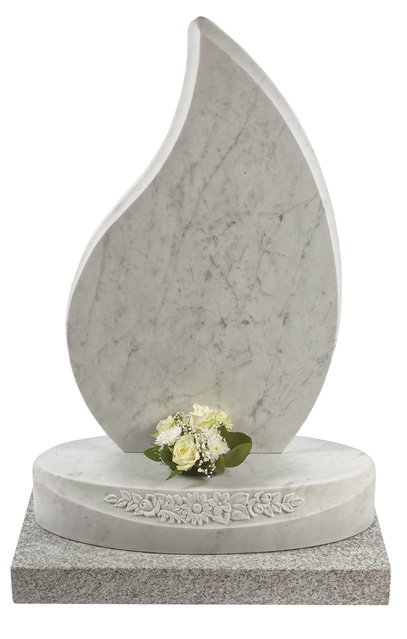Report: Memorial Masonry
As the UK passes peak life expectancy, MAB reintroduces its Cemetery of the Year Award scheme to encourage more and better stone memorialisation. And NAMM will hold its next memorial masonry trade exhibition in 2019.
No other part of the stone industry is quite as reliant on demographics as memorial masons – people tend not to buy memorials for the living. So if peak longevity has been reached by the post-World War II bulge in the population (see over the page) the long-awaited boost to the death care industry from the demise of the baby boomers could be on its way.
It is important for the memorial sector to work with others in the death care sector to help the bereaved understand the important part stones play in memorialisation and the grieving process in general. The memorial sector has to offer the bereaved the choice they expect and the burial and cremation bodies in the private, public and religious arenas have to ensure that memorial sites are attractive places to put the stones and will accept the variety of stone memorials the industry offers.
There is no greater inducement to erect a stone memorial than a calm, contemplative cemetery full of artistic memorials; a welcoming, safe place which the community wants to visit to enjoy not just the memorials but also the oasis of wildlife and rare flowers that cemeteries can become.
For many years the Memorial Awareness Board (MAB) ran a Cemetery of the Year Award to highlight, reward and encourage best practice in cemeteries.
It was successful. It did encourage many to improve the standard of their cemeteries and accept a greater variety of memorials, including kerb sets and mausoleums. Councils, which had increasingly been standardising cemeteries for their own convenience rather than the benefit of the bereaved, started to re-think their strategies and appreciate cemeteries for the amenities they can be.
Before the MAB competition became the Cemetery of the Year Awards, it had been called the Phoenix Awards, in recognition of the way these sites could be reborn from the ashes of uniformity of an outdated authoritarianism.
The last Cemetery of the Year Award was held in 2009. But now it is back. It has been revived by MAB, which has engaged Phil Potts, who has also taken on a part-time job with the British Register of Accredited Memorial Masons (BRAMM), to run it. Phil was the Executive Officer of the National Association of Memorial Masons (NAMM) until he retired last year.
Graeme Robertson Chairs MAB as well as running one of the UK’s leading memorial wholesale businesses, which changed its name to Robertson Granite and introduced a new logo during its own revitalisation when it moved into new premises in Aberdeen last year with a completely re-equipped factory and bright new showroom.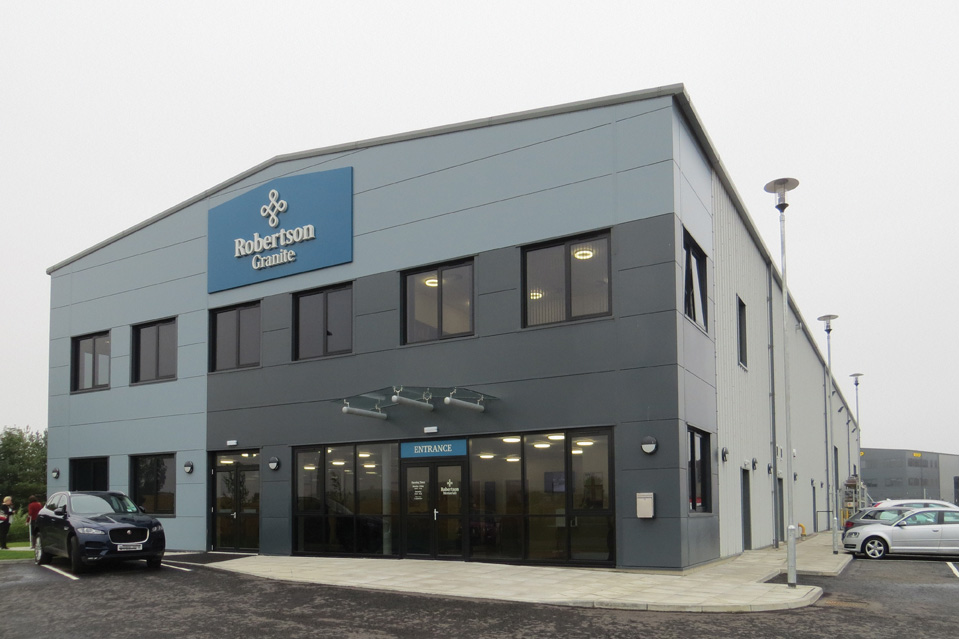
Robertson has updated its image along with a move out of the centre of Aberdeen into bright new headquarters with its factory and showroom on the outskirts of the city.
Commenting on the revival of the Cemetery of the Year Award, Graeme told NSS: “I’m hoping masons will see the connection between having a nice place to put memorials and the demand for them.
“If cemeteries are not well designed and maintained, and people don’t feel comfortable going into them, they are less likely to think about memorialisation in them.”
The Cemetery of the Year Award has the backing of NAMM, the Society of Local Council Clerks (SLCC), the Institute of Cemetery & Crematorium Management (ICCM) and The Federation of Burial & Cremation Authorities (FBCA). It is intended to present the Awards at the ICCM Learning Convention & Exhibition at the Oxford Belfry Hotel on 2 October this year, which certainly puts pressure on Phil Potts to get everything sorted in time.
If you think cemeteries you work in should enter, encourage them to take a look at www.cemeteryoftheyear.org.uk and download an entry form. And to do it quickly because entries have to be submitted by the end of July.
An online MAB publication, How to Increase Cemetery Income, which includes innovative ideas being used by cemeteries to reduce costs and increase revenue, will be sent to each entrant.
There are different categories for different size cemeteries so everyone has a fair chance of winning. There will be gold and silver awards in each category.
NAMM, meanwhile, has decided to stage another of its stand-alone memorial trade exhibitions next year (2019) once again at Warwickshire Exhibition Centre just outside Leamington Spa, which is an ideal size for the modest size of the memorial masonry sector.
After last year’s show the exhibitors were asked for feedback. One of the questions they were asked was about the frequency of the show. The memorial wholesalers wanted them to be at least three years apart, which exhibitors had also said after the first show in 2015. Their point is that they like to have new designs to introduce at the exhibition and they do not want to introduce new designs every two years, with all the printing of catalogues and price lists and updating of websites that that entails.
NAMM says other exhibitors, showing machinery, tools, fixing systems, vases, plaques, foundations and the rest were keener on an exhibition every two years because it gives their sales a boost. When visitors to the shows see and touch the products, some of which they have never seen before, they are more likely to buy them.
NAMM says it asked its members which they would prefer and the vote went in favour of every two years, so the next exhibition is next year.
But the industry is small and changes slowly. The last two shows have been good, with plenty new to see and plenty of visitors to see it. But if there becomes little new for visitors to see, they will stop coming. NAMM has been through it before, with its occasional stand-alone exhibition variously disappearing into first the Natural Stone Show in London and later the funeral industry exhibition at Stoneleigh Park, Warwickshire.
For now, though, there are still developments rolling out from the June 2017 exhibition. Graeme Robertson used the exhibition to invite the trade to come and visit the new headquarters (mentioned above) that he relocated to last year. The move was a spur to him to take a fresh look at his business. He re-equipped his factory and modified his company logo, dropping the cross, with its Christian connotations, and adopting instead a more celtic-looking, perhaps even digitally-looking device. From his newly furnished office in his new premises, Graeme Robertson said at one of the open days he held to show off his new premises on the edge of Aberdeen last year: “It’s almost like having a new business.”
Another innovation from last year’s exhibition was Belle Lapidi from Strongs Memorials. This is not just a new range, it is a new concept in memorial distribution, with distributors given exclusivity in particular areas and all the memorials sold registered and recorded. There is a gold seal on each stone and a crystal rose for the customer, as well as a certificate and a cleaning kit. Memorial masons who sign up as agents for any particular area will be given a display case of the granites from which the memorials can be made.
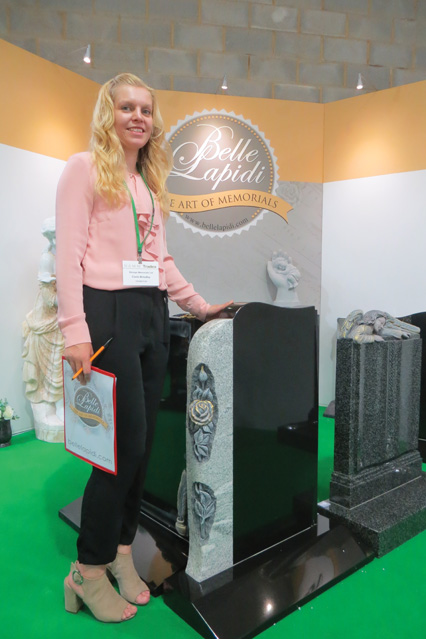
Carla Brindley, the Marketing & Design Manager at Strongs Memorials, on the company stand at the NAMM trade exhibition last year where Belle Lapidi, a new concept in memorial marketing, was launched. Belle Lapidi is now ready to be rolled out, with the collection all photographed and presented in a brochure.
The designs for the range had to be chosen and the memorials made for photography to put into a catalogue of the Belle Lapidi collection, which has taken time. But the brochure was at the printers last month (May) and Strongs said preparations to go live were in their final stages.
Carla Brindley, Strongs Marketing & Design Manager, says Belle Lapidi will be gradually rolled out across the country. She says potentially 100 or so ‘Elite’ distributors, as they will be called, will be appointed. She says the idea was well received at the memorial exhibition last year.
Carla: “The concept of all memorials being registered and customers receiving ‘authenticity’ packages with every order placed has really got people talking within the industry.”
If you would ike to become an Elite distributor and have not yet expressed your interest to Strongs, or would simply like to know a bit more about the scheme, email carla@strongsmemorials.com.
Odlings, whose craftspeople always make such an impression in the Craftex competition of memorial skills run alongside the NAMM trade show, last year launched a collection of marble memorials at the exhibition. One of them is pictured on the opening pages of this report.
Marble has gone out of fashion as a memorial stone in recent years as more durable granite has predominated. But there are always some people who want marble.
Duncan Reynolds, the MD of Odlings, has been pleasantly surprised by the take up of the range. “Most masons don’t sell an awful lot of marble but we don’t have to have many orders to keep us busy because we make them all here [at Odlings’ factory in Hull]. I would hesitate to say it’s doing amazingly well – we didn’t expect that – but we are busy with them.”
An associated company of the memorial wholesaler is Odlings MCR, which sells machinery, equipment and consumables for memorial masons. It is off to Nuremberg for the Stone+tec exhibition this month (13-16 June) to try to break into the European mainland market with its own brand rubber tape for gritblasting.
However, Duncan is just a little concerned that if the company does manage to sell tape this year, it might lose those sales after March next year if a duty is imposed on British exports after Brexit.
An innovation that has the potential to make a major contribution to the digitization of memorial masonry is SAMM from George Willcox (Granite). SAMM stands for Support Application for Memorial Masons. It is a cloud-based computerised management system that helps memorial masons to source and sell their stones, keeping track of each memorial from order to installation.
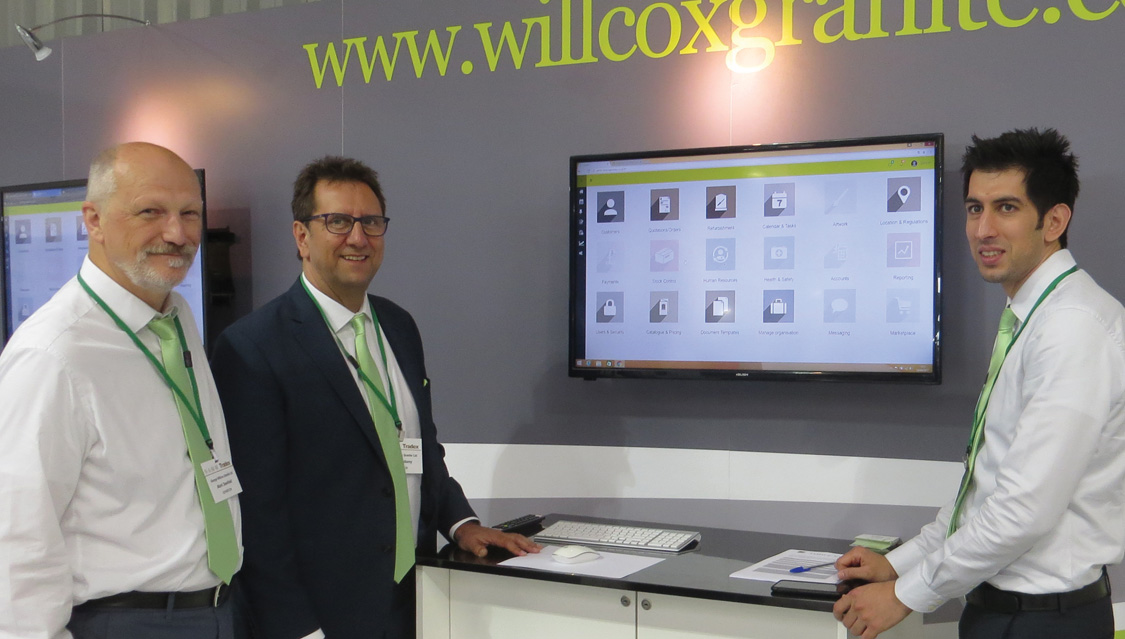 The new SAMM cloud-based management system for memorial masons will be here soon.
The new SAMM cloud-based management system for memorial masons will be here soon.
It is not just for buying memorials from Willcox. It can be used to keep track of memorials wherever they are sourced. It is something George Willcox (Granite) wanted to develop for the benefit of the industry in general, although it hopes to recover some of the considerable cost of developing it through subscriptions to it, which are expected to be about £50 a month.
But Willcox MD Simon Bellamy says: “It’s not about money. For most masons it would be life changing in terms of the way they keep records and how they store information.”
SAMM has been promised for a long time. It was expected to be ready initially in 2015. But George Willcox wanted a lot from the programme and its development has been more complicated than had been expected. To try to speed up its progress two extra software developers were employed this year and there are now three of them working on it, hoping to have it up and running this summer. NSS will let you know when it goes on general release.
Another of the wholesalers, Frank England, has just completed the purchase of the freehold of its site in Retford, Nottinghamshire, which Nick Livermore, who has been Managing Director since leading a management buy-out of the business from Pisani in 2013, says will give it more scope to explore options alongside its memorials. It plans to start with fireplaces that will mix its established skills of processing both granites and softer marbles, limestones and sandstones.
“Memorials remain our prime market,” says Nick, “and we are currently putting the final touches to a new range of designs for children and infants. This will have its own brochure to assist both monumental masons and their clients in a particularly difficult process. The memorials are influenced by both traditional and modern interpretations of nursery rhymes, toys and media characters.”
Frank England is also developing its range of memorials in White Carrara, Yorkstone and Nabresina, sales of which Nick says have increased significantly lately. Moleanos Roman Stone has just been added, which is similar to Nabresina but with a price advantage.
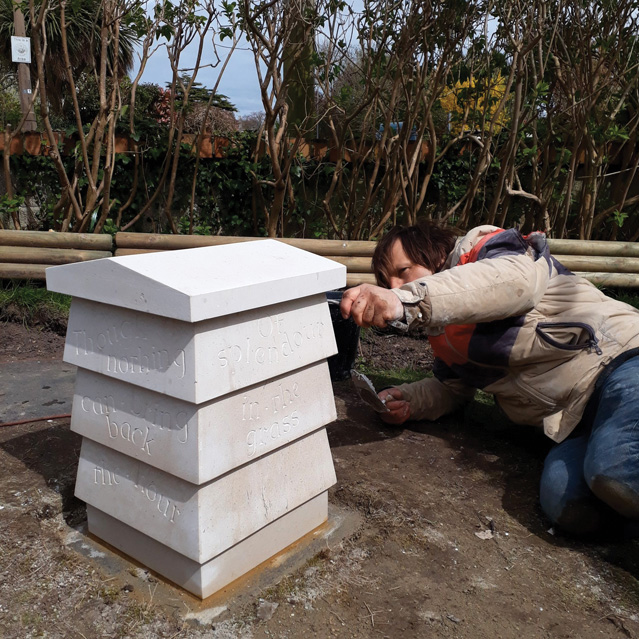
This Portland limestone beehive garden sculpture (left) is from Elysium Memorials. It contains the ashes of two people. The inscription on it is by Derek Carr, who is now in his 80s. Pictured here installing the memorial is Ed Humphris.
Another interesting development in stone memorialisation for a country that is rapidly abandoning traditional religions, especially Christianity, and tending to opt for cremation rather than burial is the idea of having a sculpture in your garden or home to commemorate someone whose ashes can be contained within the sculpture.
It not entirely a new idea – Steve Richardson of Richardson Memorials patented a range of jardinières, bird baths and sundials in the 1990s that had spaces inside them for ashes. Now it is something sculptor Kate Semple is developing in bespoke sculpture like the beehive pictured on the left that she carved.
Kate, who started out as a stonemason at Wells Cathedral, created the business called Elysium Memorials to make such memorials. “I just saw that people are starting to think differently about death now,” she says. “People are looking for something a bit more personal than a slab of granite.”
The inscription on the beehive memorial is by sculptor and lettercutter Derek Carr, who Kate used to share a workshop with.
The memorials are made in British stones (the beehive is Portland limestone) to individual commissions. And because they are not going into cemeteries or churchyards, there is no restriction on what they look like or what the inscriptions say.
Peak longevity might have been reached
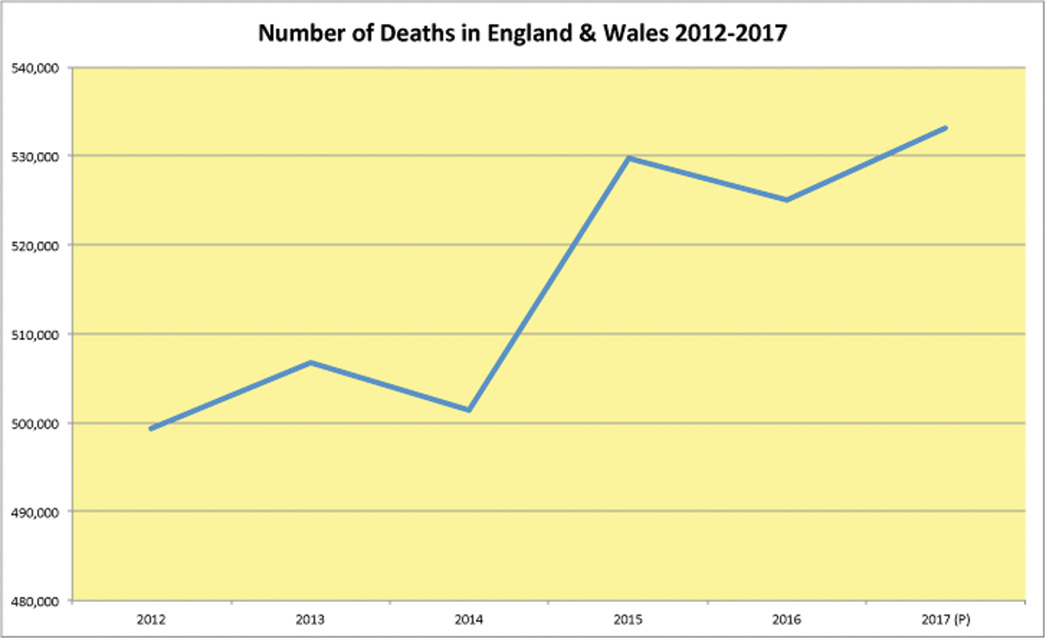
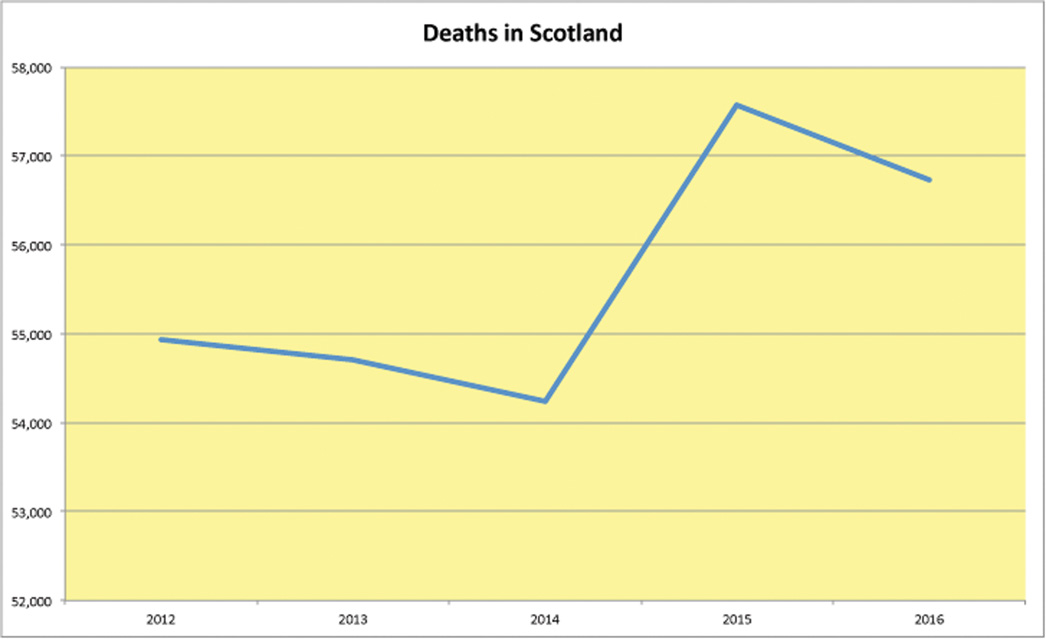
Perhaps it was food rationing that stretched on through the period of austerity after World War II and gave the population a healthy diet. Perhaps it was work and play that did not involve sitting in front of screens. Whatever it was, the baby boomers and their parents have certainly stretched longevity, which is now nearing 90 years for men and women.
They cannot, however, put off the inevitable indefinitely and it is starting to look as if peak longevity might have been reached, at least for now. The number of deaths in England & Wales and Scotland has stepped up a gear since 2015, which should be producing a bit of a boost for the death care industry, including memorial masons. Cremations seem to have reached nearly 80% of deaths now, but when people are buried most of them have a memorial on the grave.
There is no reason to suppose Northern Ireland is any different to England & Wales and Scotland but its figures were not available as NSS went to press and its 1.8million population is not going to make much difference to the overall pattern for the UK. England & Wales publish figures for the number of deaths monthly. Scotland annually and there are no figures yet for 2017. The ’flu epidemic this winter has taken its toll. Figures are available for England & Wales only, but the number of deaths in January was up 21% on January 2017. In February, it was up 3% on the same month a year earlier and in March, 5%.

